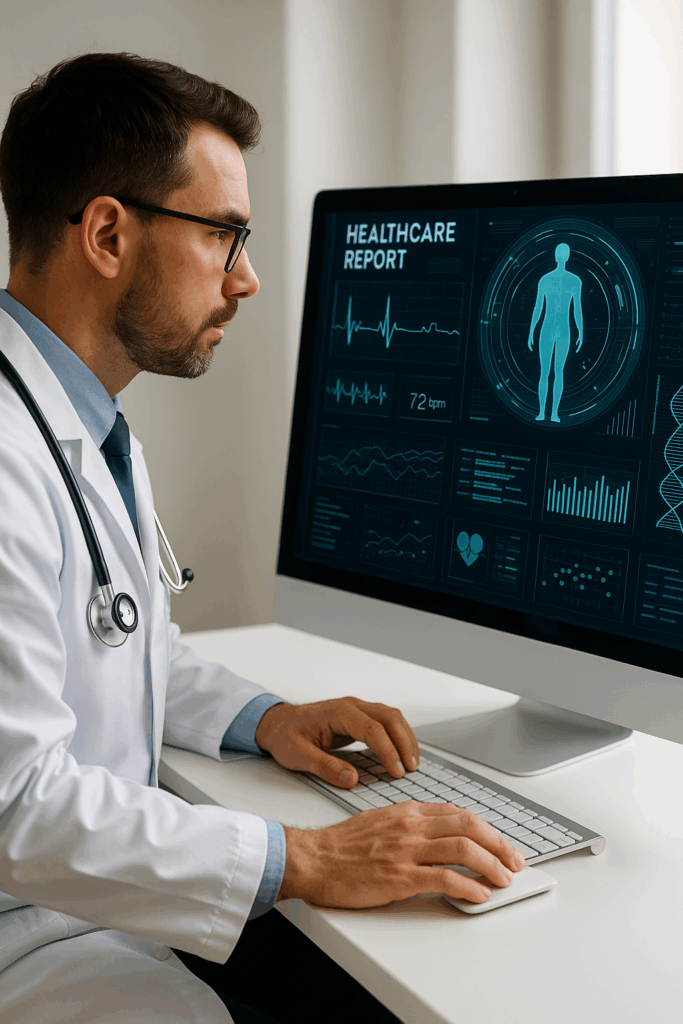Blog Summary: How is healthcare data analytics improving outcomes and efficiency? Here’s a quick breakdown.
- Transforms massive healthcare data into actionable insights
- Supports early detection, preventive care, and cost control
- Enables personalized treatment through predictive modeling
- Increases operational efficiency and staff/resource planning
- Relies on usability and organizational readiness for success
- Proven ROI: Corewell Health saved $5M and prevented 200 readmissions
- Digital Scientists offers end-to-end predictive analytics solutions
The healthcare industry continues to generate vast amounts of data from device outputs, patient monitoring, electronic health records (EHRs), and more.
When leveraged correctly, the use of data analytics in healthcare has the potential to transform the care paradigm, improving care delivery markedly by enabling earlier interventions, smarter resource allocation, and personalized treatment strategies.
In fact, that’s exactly what it’s already doing. Corewell HealthTM coordinators, for instance, saved their organization $5 million and prevented 200 patients from being readmitted by using data analytics shrewdly.
Moving into the future, as value-based care model increases in popularity, so too will the use of data analytics in the healthcare industry to provide proactive care at a higher quality and lower cost to providers.
That said, let’s discuss the types of data analytics common to healthcare, ways they’re being applied, and how they’re making an impact. Then, we’ll offer advice on how to couple organizational changes with the use of data analytics for maximum ROI and impact on patient care.
The Four Types of Healthcare Data Analytics
Data analytics refers to “the process and practice of analyzing data to answer questions, extract insights, and identify trends”.
But that’s a very broad definition. Therefore, understanding the four main types of data analytics that you’ll encounter in the healthcare industry is essential in developing a deeper understanding of specific use cases and the impact of each.
That said, here’s an overview of the 4 types of data analytics:
- Descriptive Analytics: Examines historical data with the goal of developing an understanding of “What happened.”
- Example: Tracking infection rates
- Diagnostic Analytics: Analyzes data to figure out “Why” something happened.
- Example: Determining the root cause of post-operative complications
- Predictive Analytics: Uses algorithms to forecast “What” is likely to happen next.
- Example: Identifying patients at risk for chronic illness.
- Prescriptive Analytics: Recommends actions based on insights, which are often generated from predictive analytics.
- Example: Suggesting individualized treatment plans based on unique patient data.
Data Analytics in Healthcare: Examples of Impact
As demonstrated clearly by Digital Scientists, and reinforced by various studies (including one Polish study in particular), data analytics is enhancing numerous domains across healthcare systems, from administration to outcomes.
Covering every area of impact that big data and analytics in healthcare have would be impossible in a post such as this. Still, it’s well worth providing a brief overview of several key areas where big data influences healthcare for the better, as well as a brief overview of the benefits of data analytics in each healthcare application:
- Improving Diagnostic Accuracy: Better and earlier detection of diseases and complications.
- Enhancing Treatment Planning & Personalization: Data-driven tailoring of therapies based on patient history and risk.
- Increasing Operational Efficiency: Optimizing staff, equipment, and resources and reducing unnecessary procedures.
- Reducing Costs & Waste: Preventing complications, readmissions, and overuse of resources.
- Advancing Patient Safety & Care Quality: Improving decision support and data-driven monitoring.
What Factors Make Data Analytics Successful in Healthcare Settings?
As one Jordanian study has noted, two factors have an outsized impact on whether or not the application of data analytics in a healthcare context will be successful. These include 1) perceived usefulness and ease of use; and 2) organizational capabilities and limits.
Healthcare staff must believe that tools are helpful and intuitive and understand how to use them to glean insightful data. Moreover, the organizations in which these staff members work must have the proper infrastructure, workflows, leadership support, and training. Otherwise, even the best tools may underperform and the most useful insights may not be implementable.
In other words, it’s not simply enough to deploy predictive or prescriptive systems. Institutions must also strategically invest in usability, staff engagement, and organizational readiness.
Decrease Care Costs & Increase Care Quality with Digital Scientists Data Analytics Solutions
Is your healthcare organization ready to move from theory to practice in healthcare analytics? If so, you should be ready to:
- Begin with pilots using predictive analytics to target high‑impact areas (e.g., readmissions, chronic disease risk).
- Ensure tools are user‑friendly and data sources are reliable and well integrated.
- Build internal capacity (i.e., technical skills, leadership buy‑in, & workflow alignment).
We can help with this transition and provide the technology! Our predictive analytics solutions provide end-to-end support, including model design, validation, and integration into clinical and operational workflows.



